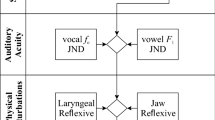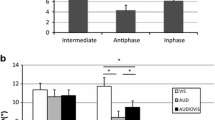Correlation analysis identified intrasensory and sensory-effector interactions of the interspike intervals of components of brainstem acoustic evoked potentials with measures of hand movement coordination. A role for the propagation of excitation via the ascending fibers of the rostral part of the pons and the lateral loop in the mechanisms of auditory-motor coordination was established. Gender differences were found in the integration of elements of the sensorimotor system depending on the lateralization of incoming auditory information and the complexity of the motor task performed. In men, the mechanism of auditory-motor coordination was less determined in nature than in women. This probably also determines their higher levelof bimanual coordination. The optimal error-free performance of the motor program in men was based on prognostication, while in women it was by correction of mistakes.
Similar content being viewed by others
References
N. Yu. Alekseenko, “Sensitivity of the auditory and tactile sensory systems in conditions of separate and combined stimulation,” Fiziol. Cheloveka, 6, No. 6, 1131–1133 (1980).
A. S. Batuev and G. A. Kulikov, “Neurophysiological mechanisms of acoustic signaling,” Fiziol. Cheloveka, 5, No. 5, 899–912 (1979).
V. V. Gnezditskii, Evoked Brain Potentials in Clinical Practice [in Russian], MEDpress-inform, Moscow (2003).
A. V. Zavyazov, Correlations of Functions in Organisms [in Russian], Meditsina, Moscow (1990).
A. V. Zavyazov and Zaitseva, “Audiokinesthetic interactions and simple motor reaction times in responses to auditory and kinesthetic stimuli,” Fiziol. Cheloveka, 6, No. 6, 34–51 (1980).
L. R. Zenkov and M. A. Ronkin, Functional Diagnosis of Nervous Diseases: Handbook for Physicians [in Russian], MEDpress-inform, Moscow (2004).
Z. Sh. Kevanishvili, E. David, R. A. Khvoles, and O. Z. Davitashvili, “Bilateral and interhemisphere asymmetry in auditory evoked potentials in monaural sound stimulation,” Fiziol. Cheloveka, 5, No. 1, 44–54 (1979).
G. A. Kulikov, Hearing and Movement. Physiological Bases of Auditory- Motor Coordination [in Russian], Nauka, Leningrad (1989).
G. A. Kulikov, “The principle of the dominant and the cortical mechanisms of auditory-motor coordination,” Ros. Fiziol. Zh. im. I. M. Sechenova, 86, No. 8, 961–967 (2000).
S. V. Medvedev, S. V. Pakhomov, and Ya. G. Abdullaev, “Interaction between physiologically significant events and distantly located neuron populations in the human brain,” Fiziol. Cheloveka, 15, No. 3, 93–99 (1989).
N. A. Plokhinskii, Biometrics [in Russian], Moscow State University Press, Moscow (1972).
The Sensory Organization of Movements [in Russian], Nauka, Leningrad (1975).
V. N. Sysoev, “Influences of the duration and intensity of loading during activity on the dynamics of the differential sensitivity of the sensory systems,” Fiziol. Cheloveka, 14, No. 5, 786–789 (1988).
G. A. Tavartkiladze, “Brainstem Auditory evoked potentials,” Fiziol. Cheloveka, 9, No. 3, 360–368 (1980).
P. V. Tkachenko, “Levels of bimanual coordination and some differential psychophysiological aspects of motor activity,” Kurskii Nauch.-Prakt. Vestn. Chelovek i Ego Zdorovie, No. 4, 17–23 (2006).
P. V. Tkachenko and I. I. Bobyntsev, “Patterns of intrasensory and sensory-effector correlational interactions of the time characteristics of visual evoked potentials and measures of bimanual coordination,” ibid., No. 1, 21–29 (2009).
P. V. Tkachenko and I. I. Bobyntsev, “Patterns of intrasensory and sensory-effector correlational interactions of the amplitude characteristics of visual evoked potentials and measures of bimanual coordination,” ibid., No. 2, 31–38 (2009).
P. V. Tkachenko and I. I. Bobyntsev, “Patterns of stable intrasensory and sensory-effector correlational interactions of the latencies of brainstem acoustic evoked potentials with measures of voluntary directed hand movements,” ibid., No. 4, 30–38 (2009).
Author information
Authors and Affiliations
Corresponding author
Additional information
Translated from Rossiiskii Fiziologicheskii Zhurnal imeni I. M. Sechenova, Vol. 96, No. 11, pp. 1107–1113, November, 2010.
Rights and permissions
About this article
Cite this article
Tkachenko, P.V., Bobyntsev, I.I. Auditory Sensory Support of Complex Voluntary Goal-Directed Bimanual Movements. Neurosci Behav Physi 42, 312–316 (2012). https://doi.org/10.1007/s11055-012-9568-0
Received:
Published:
Issue Date:
DOI: https://doi.org/10.1007/s11055-012-9568-0




